Creating and designing a container garden is an opportunity to experience an outstanding spectrum of colour and texture. Moveable feasts, container gardens offer a luxuriant start to the growing season and the potential for eye-catching displays that can be enjoyed during the hottest months of summer and into the cooler temperatures of autumn.
As soon as our chilly spring starts to warm up, many of us will feel like kids in the plant-filled candy stores we call garden centres.
In Winnipeg, Manitoba, Karen Chopp offers container design services to corporate and residential clients with her business, the Barefoot Gardener. Her seasonal container designs decorate many outdoor dining spots in Winnipeg each year.
Like many gardeners, Chopp sometimes feels the temptation to buy an individual plant on impulse, but mostly her plant choices are guided by an innate sense of design and her desire for perfect plant pairings. Chopp says she believes in resisting the urge to rush into spring planting which can result in the need to protect tender plants from the risk of frost.
Chopp uses the thriller, filler, spiller concept to create captivating, one-of-a-kind container gardens and plants densely for a lush look.
Largely self-taught, Chopp credits her earlier experience in flower arranging for her design inspirations. She worked for a local wholesaler where she arranged cut flower bouquets for grocery stores. Soon she was creating flower arrangements for restaurants and special events as well as designing container gardens. In 2019, Chopp purchased a Hijet mini truck and modified it to serve as a mobile flower shop. But then the pandemic happened.
“With more people staying home, my container garden business just took off and much of my focus now is on designing outdoor containers as well as their season-long care and maintenance,” she says.
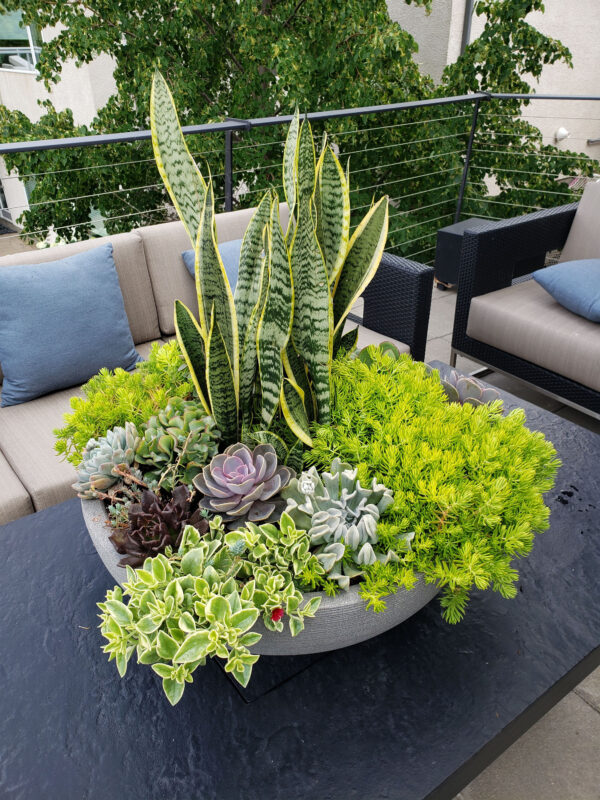
Look for healthy plants
What are some of the plant combinations, tips and techniques Chopp uses to create successful container gardens with maximum impact?
“I look for the healthiest and fullest plants I can find. I like to see what the flower looks like, but I’m looking for healthy buds rather than an explosion of flowers.” By pinching or trimming off the blooms on annuals when you first bring them home, you’ll encourage more side shoots for a bushier plant. “Don’t be afraid to trim your plants so they continue to do what you want them to do.”
Chopp says she can’t stress enough the importance of reading the guidelines on plant tags for a plant’s moisture and light requirements as well as the maximum height and width you can expect a plant to grow. It’s a shame to invest in a small jewel of a plant only to have it completely hidden from view by a nearby plant with an aggressive growth habit.
Chopp believes in designing container gardens so that they are appealing on all sides. The fact is, even with the right amount of care, she says, sometimes a particular plant doesn’t perform well or fails to meet expectations. The ability to turn a container around may allow a plant time to improve or recover, or allow you time to nurture a replacement plant.
When planning the design of your containers, consider surrounding elements such as the style of your house or the colours and textures in your flower beds or the size and shape of your patio where your container groupings will be placed. Assess the amount and intensity of light that an area receives as well as exposure to wind.
Chopp often works with very large planters. If the planters are round, she generally chooses three of a kind for each plant she is designing with. For a large square-shaped planter, she uses combinations of two of a kind. Chopp selects a centrepiece, or thriller, that’s well suited to the size of a planter. Tropical plants with a strong shape are ideal. Some favourites include elephant ears (Colocasia), canna lilies, palms and papyrus. Bushy plants such as coleus are used to build the collar around the thriller component. A favourite coleus variety that Chopp likes to incorporate into her designs is Gays Delight. Suitable for sun or shade locations, Gays Delight has lime green foliage with prominent black venation.
Trailing plants enhance the fullness of container gardens. One of Chopp’s go-to spillers is ‘Silver Nettle’ lamiastrum, a vine with silver-green foliage. She also selects trailing varieties of plectranthus, which are vigorous growers and perform well in sun or shade.
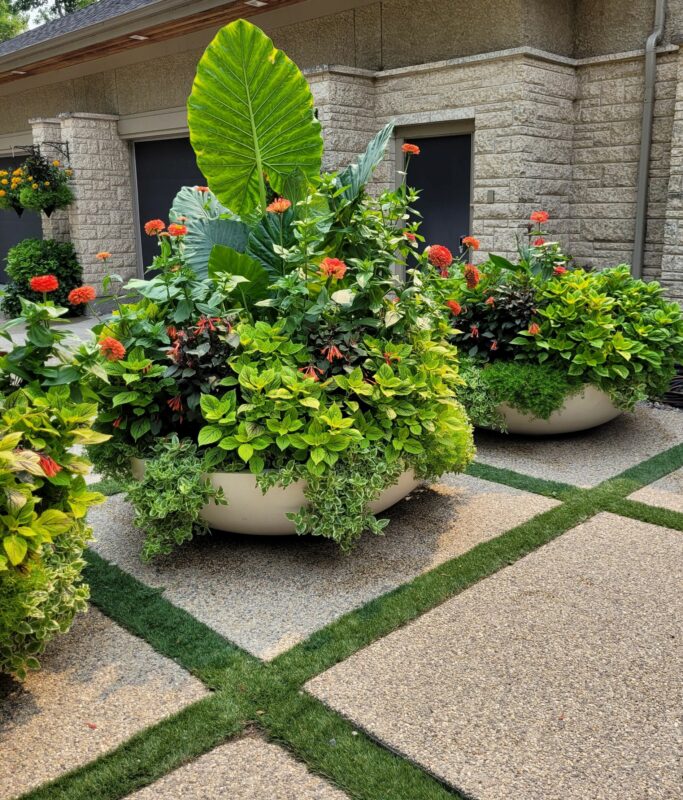
Favourite combos
Let’s take a closer look at some of Chopp’s favourite plant combinations.
For a client who wanted a border container garden consisting of a row of six large-sized planters, Chopp created an identical design in each container consisting of Benary’s Giant Series zinnias with cup and saucer vine, also known as cathedral bells, (Cobea scandens) for height above a lower layer of rudbeckia, Gays Delight coleus and a dark-leaved salvia for contrast. A layered underplanting of cigar plant or firecracker plant (Cuphea ignea) provided a delightful and unexpected flowering accent against a trailing skirt of ivy.
The upright sword-like leaves of sansevieria, a variegated cream and green tropical, is the thriller in a shallow tabletop bowl planter designed by Chopp. A generous splash of Lemon Coral sedum with spiky chartreuse foliage plays well with the rounded rosettes of succulents in varying tones accented by Dorotheanthus bellidiformis Mezoo Trailing Red, an easy maintenance trailing succulent with fleshy green leaves with white edges.
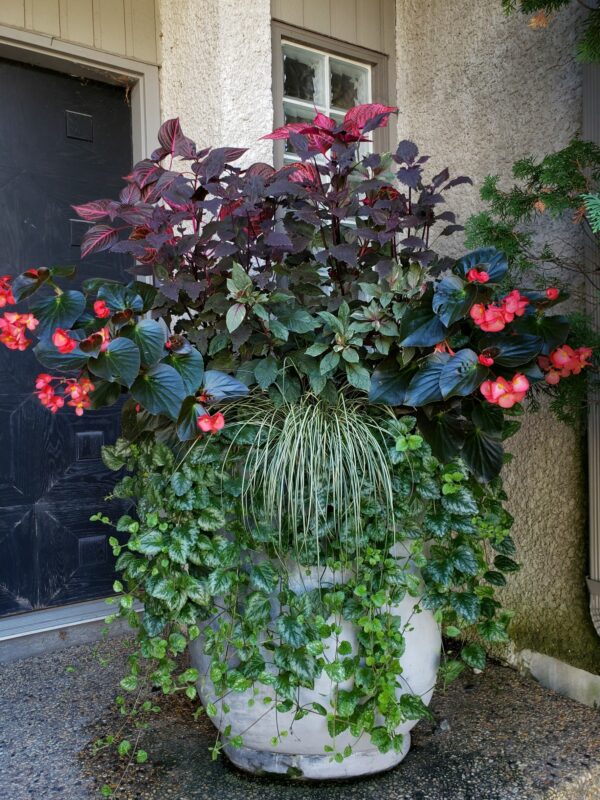
When Chopp met with a prospective client who wanted to showcase three massive bowl containers in a courtyard, she couldn’t wait to create an enticing design that would make a dramatic statement. For the thriller, Chopp selected elephant ears , a tropical plant with bold, shield-shaped foliage. The upright stems of ‘Benary’s Giant Salmon Rose’ flowers also provided vertical interest while complimenting ‘Gartenmeister’ fuchsia’s clusters of tubular flowers. Multiple coleus plants filled out the design along with the indestructible Mezoo Trailing Red. “Most elephant ears can handle the sun,” says Chopp, who takes care to ensure they are placed in a location that offers some shelter from the wind. “Elephant ears do best with consistent watering.”
Against the neutral backdrop of a grey fence, Chopp combined the fine texture of majesty palm (Ravenea rivularis) and vivid colour of ‘Red Sister’ cordyline with white-flowered New Guinea impatiens, artemisia and silver nettle. The silver foliage of artemisia is an ideal accent in containers, says Chopp, and there are many upright and short, trailing varieties to choose from.
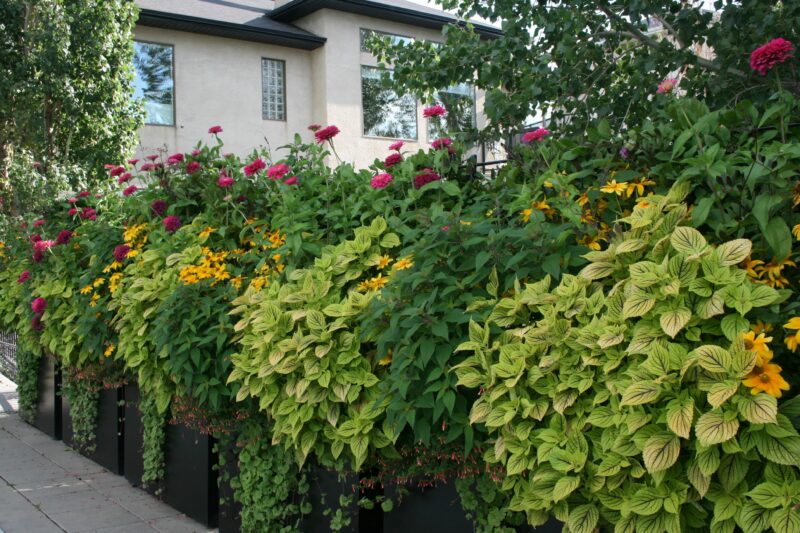
Photo credit: Karen Chopp
For a front door planter in a part-shade location, Chopp paired Dragon Wing Red begonia with foliage plants such as magenta-coloured bloodleaf (Iresine herbstii) that contrasted with a smoky plum-purple coleus variety and the unique texture and mounding habit of Carex hajijoensis Evergold, a Japanese sedge.
When deciding where to place your pots, consider how a space is going to be used, says Chopp. “It’s important how you use plants around a dining area, especially if you have a tighter space.” When planting around a patio dining area, flowers that attract a lot of bees or wasps can make guests nervous. If bushy plants are too close to a heavy traffic area, there can also be the risk of pollen transfer. Leave enough room to walk alongside containers. This will lessen damage or plant breakage.
Consider the proximity of a container grouping to a pool area. Chlorine splashes can damage plants nor is it desirable to have a heavy bloomer shedding its petals in the pool, says Chopp.
Chopp sources everything she needs from garden centres in her surrounding community. When planting, she uses a slow-release, granulated fertilizer that she waters in well. By mid-season, if needed, she supplements with a liquid fertilizer.
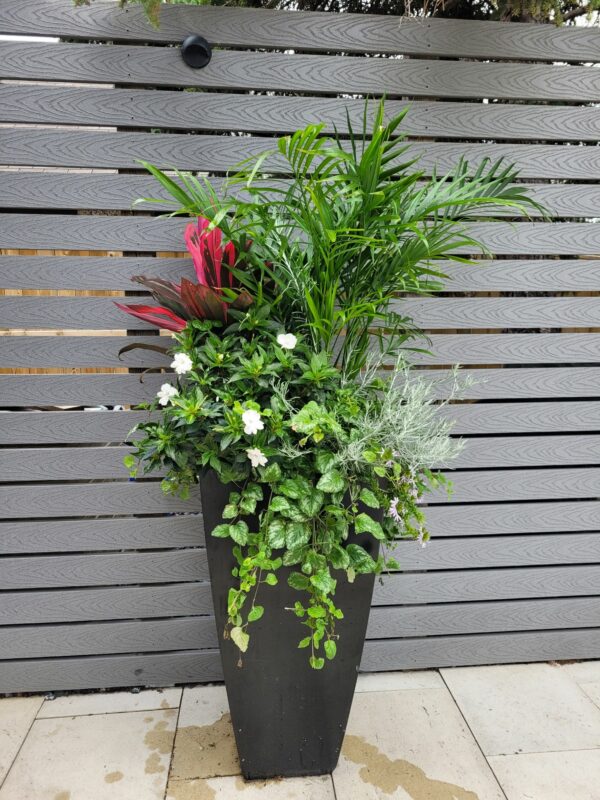
Photo credit: Karen Chopp

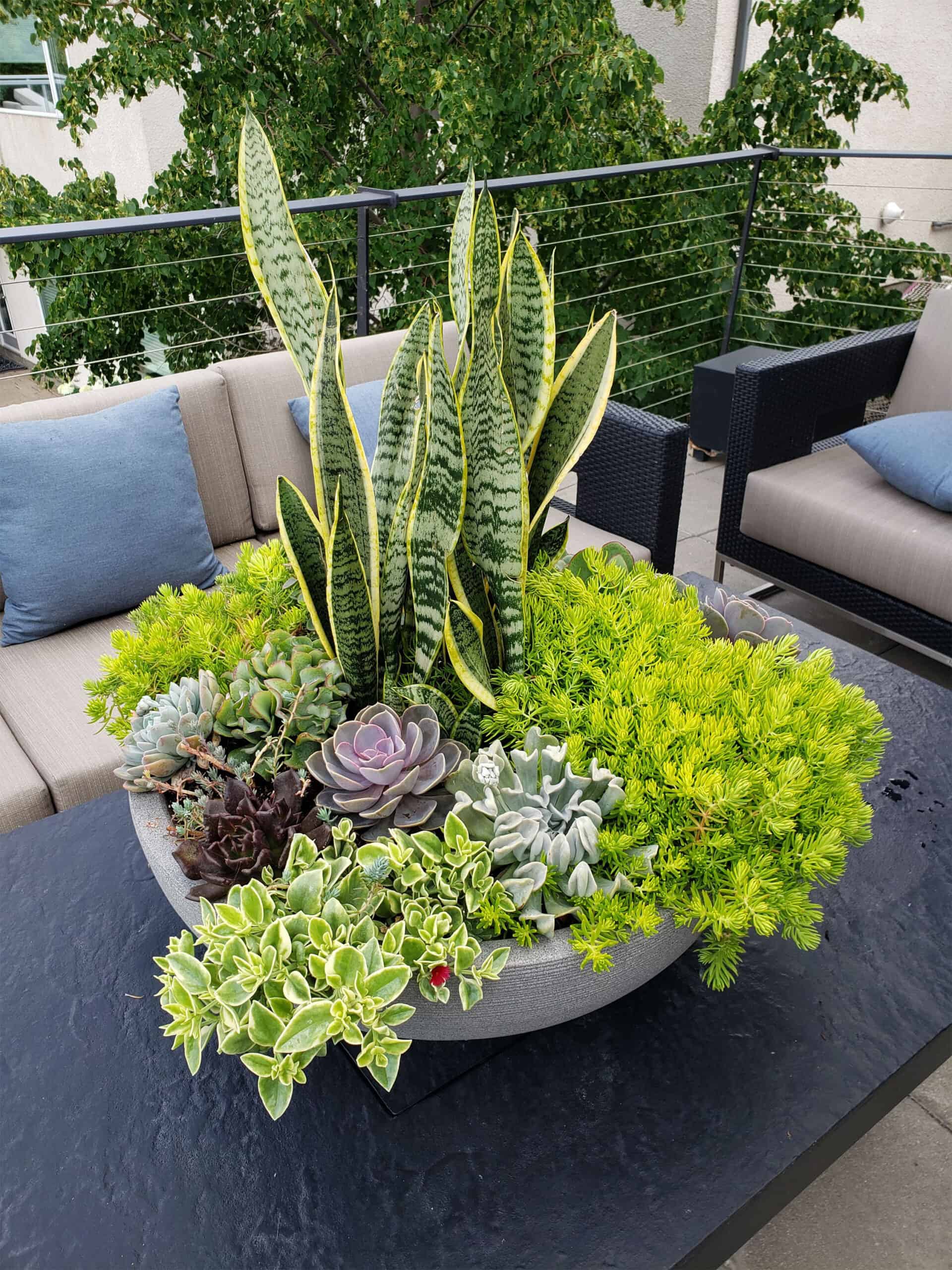
Very creative and outstanding plant containers! My interest is having outdoor plant containers within a rock garden setting. The challenge is; it is an open concept with wildlife such as deer, rabbit, fox, wild turkey, coyote and other small animals that will potentially venture through. Would you be able to provide some tips and a list of plants?
Thank you